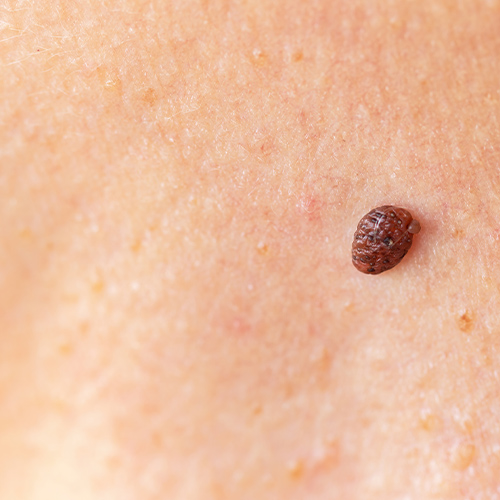Do you have a pesky spot on your body that you’ve always wanted to eliminate? We can reduce and remove benign lesions such as moles, skin tags, cherry angiomas, and more at SKIN Clinics.
Get The Facts
Benign Lesion Removal is a non-invasive laser therapy that uses specific wavelengths to reduce the size, appearance, and depth of lesions by repairing and regenerating skin cells. We require lesions to be cleared by a physician before your consultation. Once your lesion has been diagnosed as benign, we can remove the spot using the laser.

Before You Arrive:
+ Please ensure you have filled out your Health History/Intake form before your appointment. If you are unable to complete it, please arrive 15 minutes early
+ We recommend eating a light snack or meal 30min-1hr before your appointment
+ Ensure the treatment area is clean and free of any makeup, lotion, oils, self-tanning products, or deodorants
+ Must have a physician check lesion and diagnose it as benign before removal
What to Avoid:
Please avoid the following:
+ Tanning and direct sun exposure including self-tanning products for at least 4 weeks prior
+ Alcohol and smoking for 24 hours prior
+ Hot tubs, saunas, and steam rooms for 24 hours prior
+ Neuromodulators for at least 2 weeks before in the treatment area
+ Filler for at least 4 weeks before in the treatment area
+ If the skin is compromised (peeling, sunburnt, warm to the touch, etc.) your appointment will be rescheduled
+ Must be off of oral isotretinoin (Accutane) for a minimum of 6 months prior
+ It is our policy not to provide treatment if you are pregnant or breastfeeding
Downtime:
+ Minor redness, swelling, bruising, and sensitivity to the treatment area are normal
+ Minor pinpoint bleeding possible
Post Care:
+ Wear loose clothing to avoid friction to the treatment area
+ Keep the area clean and dry
What To Avoid:
Please avoid the following:
+ Strenuous exercise for 24 hours
+ Hot tubs or baths, saunas, spas, or steam rooms for 2 weeks
+ Sun exposure for the course of treatment
+ Scrubbing or exfoliation for 1 week
Follow Up:
+ We recommend 1-3 treatments spaced 4-8 weeks apart for optimal results
+ Maintenance treatments may be required
+ Removal of unwanted skin abnormalities
+ Promotion of collagen for new skin production
+ Improved blood circulation in treatment area
+ Reduced inflammation
Avoid sunbathing, tanning beds, waxing, chemical peels, or collagen injections for two weeks before the procedure. Avoid perfumes, deodorants, or any potential irritants in the treatment area before and after treatment. Avoid aspirin, anti-inflammatory drugs, and herbal supplements due to the increased risk of bleeding.
It can be a flat mark on your skin that is a different color than your skin tone (macule or patch) it can be an elevated, pimple-like bump (papule or plaque) or an elevated, solid bump (nodule).
An area of abnormal tissue. A lesion may be benign (not cancer) or malignant (cancer).
No, as the procedure is for aesthetic reasons.
The chances of a benign lesion growing back after removal depend on the specific type of lesion. Some lesions, such as seborrheic keratoses, can occasionally recur. However, many benign lesions, once completely removed, do not grow back.
The recovery time varies depending on the size and location of the lesion, as well as the method of removal. In most cases, healing occurs within a few weeks, during which the wound may scab, crust, or form a small scar. Following your post-procedure instructions provided by the dermatologist or skincare professional can help promote proper healing.
Terms and conditions apply.
Follow our socials to stay up-to-date.